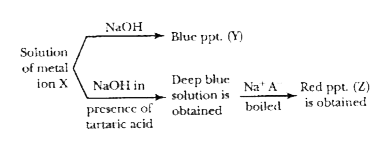The cation is ________ and the anion is ________ than the parent atom.
smaller, bigger
smaller, smaller
bigger, bigger
equal, bigger
The correct Answer is:A
To solve the question regarding the size comparison between cations, anions, and their parent atoms, we can follow these steps:
1. Understand the Definitions:
- Cation: A positively charged ion formed when an atom loses one or more electrons.
- Anion: A negatively charged ion formed when an atom gains one or more electrons.
- Parent Atom: The neutral atom from which the cation or anion is derived.
2. Cation Size Comparison:
- When an atom loses electrons to form a cation, it loses the outermost electron shell. This results in a decrease in electron-electron repulsion and an increase in the effective nuclear charge experienced by the remaining electrons.
- As a result, the cation is smaller than the parent atom.
3. Anion Size Comparison:
- When an atom gains electrons to form an anion, it adds extra electrons to the outer shell. This leads to increased electron-electron repulsion among the electrons in the outer shell.
- Consequently, the anion is larger than the parent atom.
4. Conclusion:
- Therefore, we can conclude that:
- The cation is smaller than the parent atom.
- The anion is larger than the parent atom.
5. Final Answer:
- The cation is smaller and the anion is larger than the parent atom.
- Cation: A positively charged ion formed when an atom loses one or more electrons.
- Anion: A negatively charged ion formed when an atom gains one or more electrons.
- Parent Atom: The neutral atom from which the cation or anion is derived.
- When an atom loses electrons to form a cation, it loses the outermost electron shell. This results in a decrease in electron-electron repulsion and an increase in the effective nuclear charge experienced by the remaining electrons.
- As a result, the cation is smaller than the parent atom.
- When an atom gains electrons to form an anion, it adds extra electrons to the outer shell. This leads to increased electron-electron repulsion among the electrons in the outer shell.
- Consequently, the anion is larger than the parent atom.
- Therefore, we can conclude that:
- The cation is smaller than the parent atom.
- The anion is larger than the parent atom.
- The cation is smaller and the anion is larger than the parent atom.
Topper's Solved these Questions
- CLASSIFICATION OF ELEMENTS AND PERIODICITY IN PROPERTIES BOOK - CBSE COMPLEMENTARY MATERIALCHAPTER - CLASSIFICATION OF ELEMENTS AND PERIODICITY IN PROPERTIES EXERCISE - TRUE AND FALSE TYPE QUESTIONS
10 Videos
- CLASSIFICATION OF ELEMENTS AND PERIODICITY IN PROPERTIES BOOK - CBSE COMPLEMENTARY MATERIALCHAPTER - CLASSIFICATION OF ELEMENTS AND PERIODICITY IN PROPERTIES EXERCISE - MATCH THE COLUMNS
4 Videos
- CLASSIFICATION OF ELEMENTS AND PERIODICITY IN PROPERTIES BOOK - CBSE COMPLEMENTARY MATERIALCHAPTER - CLASSIFICATION OF ELEMENTS AND PERIODICITY IN PROPERTIES EXERCISE - 5 - MARKS QUESTIONS
6 Videos
- CHEMICAL THERMODYNAMICSBOOK - CBSE COMPLEMENTARY MATERIALCHAPTER - CHEMICAL THERMODYNAMICSEXERCISE - Hots Questions
3 Videos
- ENVIRONMENTAL CHEMISTRYBOOK - CBSE COMPLEMENTARY MATERIALCHAPTER - ENVIRONMENTAL CHEMISTRYEXERCISE - UNIT TEST
9 Videos
Similar Questions
Knowledge Check
Consider the following statements :
I. The radius of an atom anion is larger than that of the parent atom .
II. The ionization energy generally increases with increasing atomic number in a period.
III. The electronegativity of an element is the tendency of an isolated atom to attract an electron.
Which of the above statement is/are correct?AI aloneBII aloneCI and IIDII and IIIAssertion: Radius of the ion is always smaller than the parent atom.
Reason: Ion is formed by the loss or gain of electrons by the parent atom.ABoth A and B true and R is the correct explanation ABBoth A and R are true but R is not a correct explanation of ACA is true but R is falseDA is false but R is true
The cation X and the anion A are respectivelyANH+4,CH3CO−2BHCO−2,Cu2+CPb2+,C2O2−4DCu2+,HCO−2
Give reason for the following.
a) The electron gain enthalpy of O is less negative than that of S.
b) The size of anion is larger than the parent atom.
View SolutionExplain why cations are smaller and anions larger in radii than their parent atoms?
View SolutionThe cyclopentadienyl cation is _________ while cyclopentadienyl anion is ________
View SolutionExplain why callions are smaller and anions larger in radii than their parent atoms?
View SolutionThe radius of cation is 100 pm and that of anion is 188 pm, then the coordination number of cation is __________.
View Solution